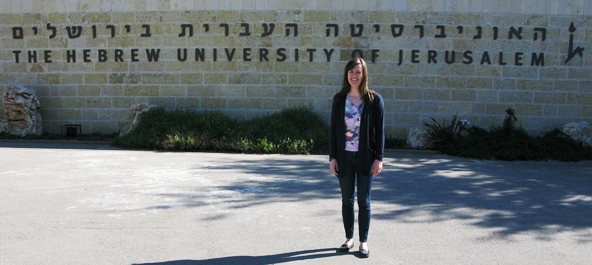Voices from the Sylff Community
Feb 26, 2015
Why Do Some Organizations Perform Better Than Others?
Investigating the Importance of Context and Strategy Choices
Mirjam Goudsmit1, a Sylff fellow at the UNSW Australia Business School, used her Sylff Research Abroad award to investigate how organizations are affected by “turbulence,” or radical, unpredictable changes in the business environment. For the empirical phase of her project, she went to Israel, which has a long history of instability, conducting research at the Hebrew University of Jerusalem and elsewhere. Her research aims to help organizations achieve their business objectives in various turbulent conditions. A summary of her research is presented below.
* * *
At the core of strategic management research is the explanation of performance differences among business organizations. I look at this question from the perspective that organizations are increasingly confronted with turbulence in their competitive contexts. The term turbulence is considered here as radical, unpredictable change in the environment. The situation is unstable, unsettled, and in turmoil. Instead of calm waters, imagine a turbulent sea that is choppy, bumpy, and at times violently rough. Instabilities are irregular. Organizations have to navigate such waters, that is, such competitive situations.
Triggers of turbulence in a business context include technology developments, political issues and conflicts, unsettled regulations, and ubiquity of information.
Overall, these triggers change to different degrees; some changes are radical and transformative in nature—they disrupt the status quo in an environment and have the potential to alter expectations and what is considered valuable. Think of an unexpected and radically new product that profoundly alters the market. Existing products are afterwards considered dated and less valuable, the willingness to pay for those products decreases, and they are eventually perceived as largely useless and are displaced. A familiar case is the introduction of the iPhone with its significant impact on the nature of the mobile phone industry.
In today’s unsettled times, destabilizing forces operate with increased frequency and impact and present significant difficulties for organizations. One important challenge is to effectively make strategy choices—choices that entail courses of action necessary for carrying out long-term organizational objectives. This challenge follows from the increased difficulty of predicting the future and reduced guidance from experience, that is, what worked in the past may no longer work in the future. Strategy choices can help explain performance differences among organizations. Specifically, ineffective choices may result in decreased performance or even threaten and undermine the survival of organizations. Understanding more about effective strategy choices in turbulent contexts, I believe, is therefore important.
In my research, I am curious about strategy choices that organizations make and how different turbulent conditions might influence the effect of these strategies on organizational performance. The empirical project consists of two sequenced and interconnected phases. In Phase One the aim is to explore and understand more about the research topics through interviews, while the aim of Phase Two is to test and provide statistically valid insights through a questionnaire. The first phase is designed to carefully further develop the research and ideas as a foundation for large-scale investigation in the second phase.
My Research Abroad
In the spring of 2014 I went to Israel for the first empirical research phase. This context represents a long history of instability. My research activity during this time included fieldwork, interviews with organizational decision-makers, and discussions with experts. The visiting institution, the Hebrew University of Jerusalem, provided valuable support, such as office facilities and the opportunity to exchange ideas and discuss research with the faculty and graduate community. Findings from this research abroad provided insights into how decision-makers think about turbulence and strategy in the context of Israel. This exploration, based on the interviews I conducted with businesses, has led to several observations and preliminary insights that are being put to the test in the second empirical phase. I will hereafter touch on some interesting insights. First, the findings suggest that turbulence and its consequences are more complex than previously assumed. Between and within organizations, decision-makers were found to recognize changes in their environment to different extents and in different ways. For example, one manager emphasized the importance of commodity prices and the natural environment, while another emphasized the importance of competition. In another example, one manager considered the environment, or an aspect in that environment, as relatively stable and predictable, while another considered it as relatively unstable and unpredictable.
Turbulence is thus not as universal as previously understood, that is, similar across all organizations and for all decision-makers. How dissimilar perspectives matter for strategy choices and their effectiveness need further investigation. Moreover, organizations were found managing simultaneous, sometimes contradictory changes. An illustration of such environmental factors is limited but major regulatory changes occurring at the same time as many, small changes in relevant technology. Organizations therefore have to attend to this complexity and take action that is possibly more systemic—and thereby more multifaceted.
Second, the unique geographical location in which organizations operate is pertinent. There are context-specific aspects of the situation in Israel, such as the sizeable power of labor unions in some sectors that organizations have to negotiate. Also there is a heightened risk of disruptive geopolitical issues with the potential of escalation and extreme consequences, such as hostility and conflict. These possible issues are revealed on the radar of some organizations to varying degrees, but they are indeed exceptional circumstances—infrequent and unforeseeable. As such, these issues resemble forces majeure, which cannot reasonably be known in advance, controlled, and prepared for.
Some organizations are more exposed to this category of issues, such as when facilities are located in areas of contention. When situations arise, organizations can sometimes only react, such as by closing retail stores or moving portable assets, including employees, to another site, with little room for further maneuvering. Often short-term, quick responses emerge when situations occur that are in conflict with long-term (planned) strategies. How to manage the conflict is exposed as a challenge for organizations.
Furthermore, amidst disruption many organizations aim to continue their business as much as possible. Conservative financial planning and contingency planning were found to be prudent strategic approaches for some organizations to continue achieving outcomes in such a situation, such as by reducing risk and preparing for scenarios. An additional observation is that the local country and organization context more frequently extend across borders. The above geopolitical issues are examples of this observation. Another is that many industries and products were found to be fundamentally global in nature so that competition is essentially global.
Organizations were also impacted by rulings from other countries’ regulators, at distant locations. An example is the Foreign Account Tax Compliance Act that requires foreign financial institutions to report directly to the US government all clients who are “US persons.” This is a big change that is having a big impact on financial institutions worldwide. Crucially, my findings have uncovered the fact that global issues of turbulence can rapidly become local issues and, conversely, local issues can rapidly become global ones for organizations. Organizations therefore have to navigate this increasingly interconnected world that might call for different strategies.
Finally, the findings suggest numerous different strategy choices for organizations, like the several already mentioned above. Some strategies are specific to a particular industry or organization, while others are more general in nature. For example, several managers indicated that their organizations faced persistent constraints from their environment through unions, interest groups, or regulatory bodies. Organizations differed in their responses to these constraints, however. Some adopted a more reactive approach and largely responded to changes after they occurred. Others adopted a more proactive approach and largely anticipated changes before they occurred. Which type of strategy is more effective under what circumstances needs to be further understood.
In sum, in these increasingly turbulent times, I believe this research is meaningful and relevant for both academics and practitioners. As an important foundation and next step for further research, the findings provide more understanding of the important topics of strategy choices and turbulence. The overriding intent of this project is to support organizations achieve organizational objectives in different turbulent conditions. With this research I aspire to benefit organizations worldwide and, ultimately, contribute to the future prosperity of society at large.
1For supporting this research abroad, my tremendous gratitude goes to the Ryoichi Sasakawa Young Leaders Fellowship Fund, the host institution Hebrew University and its academic community, home institution UNSW Australia and primary academic advisor Dr.George Shinkle, all intermediaries, including the Israel-Australia Chamber of Commerce, and organizations and people who participated in this research for their generous time, efforts, and insights.

